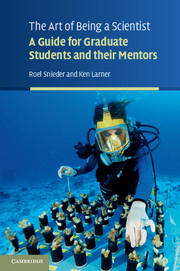Book contents
- Frontmatter
- Contents
- 1 Introduction
- 2 What is science?
- 3 Choices, choices, choices
- 4 The adviser and thesis committee
- 5 Questions drive research
- 6 Giving direction to our work
- 7 Turning challenges into opportunities
- 8 Ethics of research
- 9 Using the scientific literature
- 10 Communication
- 11 Publishing a paper
- 12 Time management
- 13 Writing proposals
- 14 The scientific career
- 15 Applying for a job
- 16 Concluding remarks
- Appendix A Further reading
- Appendix B A sample curriculum
- Appendix C The Refer and BibTeX format
- References
- About the authors
- Index
6 - Giving direction to our work
Published online by Cambridge University Press: 05 June 2014
- Frontmatter
- Contents
- 1 Introduction
- 2 What is science?
- 3 Choices, choices, choices
- 4 The adviser and thesis committee
- 5 Questions drive research
- 6 Giving direction to our work
- 7 Turning challenges into opportunities
- 8 Ethics of research
- 9 Using the scientific literature
- 10 Communication
- 11 Publishing a paper
- 12 Time management
- 13 Writing proposals
- 14 The scientific career
- 15 Applying for a job
- 16 Concluding remarks
- Appendix A Further reading
- Appendix B A sample curriculum
- Appendix C The Refer and BibTeX format
- References
- About the authors
- Index
Summary
SET GOALS
If you don't know where you are going, any road will take you there.
Lewis Carroll, 1832–1898It's a dream until you write it down; then it's a goal.
Simon, 1998It's difficult to imagine embarking on a journey, adventure, activity – any endeavor – without having a goal, however vague that goal might be. Even if you don't study a map before going on a road trip, you at least think to put gas in the car. Goals for a holiday might be explicit or implicit, and they can range from short term to intermediate and somewhat long. A career in science, starting from your period in graduate school and continuing into a life of research, is a journey, a long one. Much more so than for a holiday journey, the thoughtful setting of explicit goals is of crucial importance for a successful career in research and for success in the research itself. By success, we mean here the achievement of valuable contributions in your field, accomplished with a good deal of pleasure and a minimum of needless pain and time wasted.
Goals give direction to our actions. By clearly choosing and defining goals, we provide a focus for action needed to arrive at a hoped-for destination or outcome. Defining goals not only helps in creating a mental commitment to take certain action, it also enables us to formulate a plan of attack toward reaching the desired ends.
- Type
- Chapter
- Information
- The Art of Being a ScientistA Guide for Graduate Students and their Mentors, pp. 81 - 92Publisher: Cambridge University PressPrint publication year: 2009



